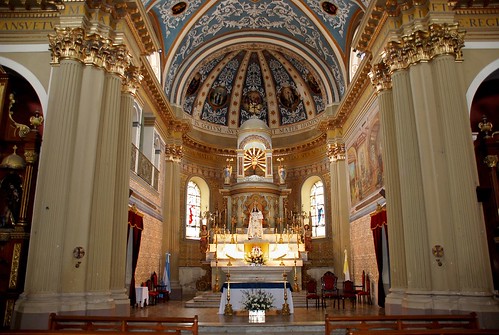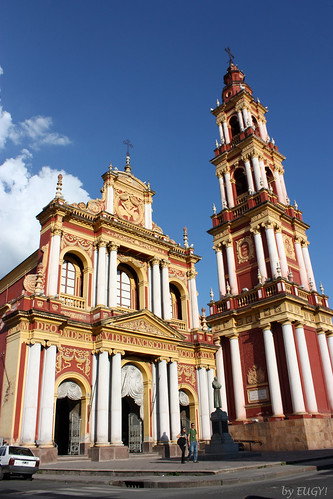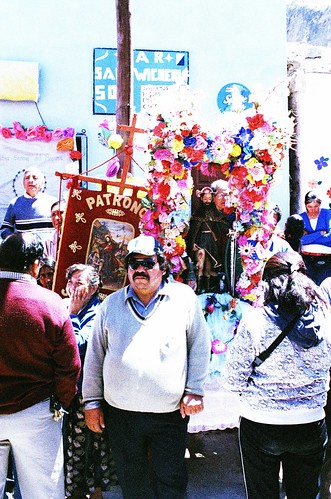![Catedral Basilica de Salta, Argentina [3607] by Tristan Appleby.](http://farm3.static.flickr.com/2547/4178835460_aaa731f5b8.jpg)
The tours of architectural type that occur in Argentina, are rich in terms of tourism, this mainly by presenting their old buildings that have left us a historical and architectural legacy.
Religious Roads in Salta:
At every step we take in this journey through the historical and architectural monuments of Salta, no doubt we’ll be amazed. Well let’s start with the tours in Salta, which are:
Convent of San Bernardo:
Everything happened so that we imposed on us here in Salta personality. The convent of San Bernardo sober is white and massive. It belongs to a time before the colony when he was still sleeping Salta.

St. Bernard was the first patron of the city. Who gave him that title? Everything has its history. One day the Indians decided to delete the valley settlement of the conquerors, but in one attack the figure of a pale and lonely man short, with a white layer wind rippled unreal, terrorized. Two of the infidels who had fled over the years entered the chapel of the convent bound adobe and gave a hoot to see the frightened little man who had mysteriously with his goodness.
Earthquakes and centuries did their best to eat away at the monastery until death, but the Salta, civilizing hardened, not only prevented but also initiated a hospital there where patriots attended the founding of Argentina, and then a convent for the Carmelite. There is a splendid building vocation.
Candelaria Church :
A few blocks shows the church of Nuestra Senora de la Candelaria de la Viña. The very name already is a poem that marks them for their cantito musical Salta. Seduce the elegance of this great church, sophistication achieved with lead and gold. He has a master dome and a tower that makes a couple sober, carefully observing the children of the Virgin to walk the streets.

Museum Uriburu:
Later we will continue the tour of the archaeological treasures of religion and tell why the Salta Cathedral houses a miracle.
Now we will analyze the daily life of this colonial Salta, who had the bravery and pride which gave him the Queen of the colonizing power from Peru. The pride of kings Salta had roots in Europe and America.
The colonial houses of their neighbors were related to those of Lima, Cartagena, Sucre and Guadalajara. It transports us to date the House of Uriburu today José Evaristo Uriburu Historical Museum.
In Caseros street (called Calle Real de San Francisco when they built the house in the eighteenth century) is a front succulent, very wide adobe walls repainted white, with a dark doorway. You cover six wards which are objects that belonged to Uriburu, Jose Evaristo and Jose Felix.
Leguizamon House:
La Casa de Juan Galo Leguizamon (also known as Casa de Don Pablo Arias Velazquez) made the corner of Caseros and Florida. It was built in 1806. It has the bright pink walls, doors green, black irons and sharp angles.
San Francisco Church:
The interior of the church contains amazing treasures: as at San Pedro de Alcantara of Alfonso Cano, a painting of San Francisco, probably by Zurbaran, and a carving of St. Francis de Rivera, a library with 40,000 volumes, including incunabula, 1488 , a Christ Child eighteenth-century Cuzco, a virgin polychrome from the same period and an image of the Virgen de las Nieves, the first maiden who entered the city of Salta.

Cathedral of Salta:
We finally arrive at the Cathedral. Turned many times the forces of evil, this monument to the persistence of Faith rose again. And today there before the town square, around which to tour the Argentine North. Every time I raised was the most magnificent cathedral.
In 1692 this church withstood an earthquake. The explanation that has survived is to be found exactly a century ago, when a drawer was found floating at sea off the port of Callao. Inside the drawer found a crucified Christ. Christ went on his journey to Salta, where he went to another drawer to those days of earthquakes. Then Father José Carrión dreamed of the angel who revealed that he Crucified God’s work saved from the fury of the bowels of the earth.
And so he ran to place it next to the Virgin, which had fallen towers. Then the earthquake stopped and were born Our Lord and Our Lady of the Miracle, and processions that resume in the city every September 15. All to celebrate the dream, that miracle.

Religious Tourism in Salta is part of the festive life in Argentina!
Leave a Reply
You must be logged in to post a comment.
Recent Comments